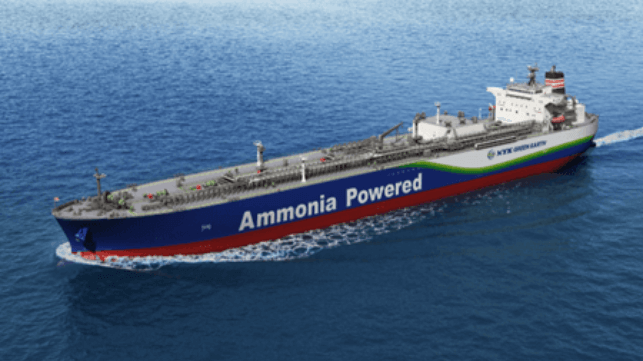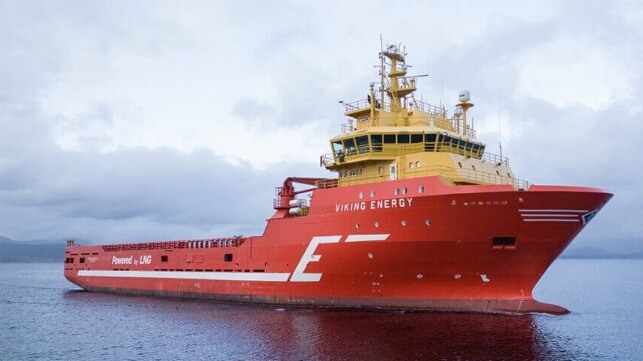
Published Aug 27, 2024 12:36 PM by The Maritime Executive
[By: NYK Line]
The world’s first accreditation* for “Machinery Room Safety for Ammonia” (MRS) will be granted by ClassNK for the ammonia-fueled medium gas carrier (AFMGC) currently being developed by a consortium that includes Nippon Yusen Kabushiki Kaisha (NYK) and Nihon Shipyard Co., Ltd. (NSY). MRS is Class notation demonstrating a ship is equipped with excellent ammonia safety measures for the machinery room. MRS also confirms the vessel meets the highest safety measures under the guidelines for ammonia-fueled ships.
Background
The consortium to which NYK and NSY belong is aiming for AFMGC delivery by the end of November 2026. The vessel development is under the Green Innovation Fund Project*** by Japan’s New Energy and Industrial Technology Development Organization (NEDO). One of the biggest challenges in the ship’s development is to overcome toxicity in the machinery room. It is essential to have measures to keep the crew safe, such as a design to avoid ammonia leakage from piping and tanks. To overcome toxicity, the consortium has conducted a risk assessment reviewed by ClassNK, risk assessments and safety measures from a user’s point of view led by NYK’s engineers, and a study of the ship’s specifications to realize the world’s highest level of safety.
Overview of MRS Notation
The minimum design requirements for using ammonia safely on board are regulated in the ammonia-fueled ship guidelines issued by ClassNK. To receive an MRS notation, it is necessary to satisfy the optional functional requirement to minimize personal exposure to leaking ammonia in the machinery room. This notation shall be granted only to ships that meet the functional requirement and secure the highest level of safety.
Future Developments
The consortium continues vessel development, the creation of operation manuals for actual operations, etc., aiming for delivery by November 2026. Moreover, we aim to further improve safety for ammonia-fueled ships through technical know-how and achievements, including MRS accreditation, with the collaboration of consortium members.
The products and services herein described in this press release are not endorsed by The Maritime Executive.
Eidesvik, Equinor and Wärtsilä Pl Retrofit for First Ammonia-Powere OSV

In a pioneering project, Eidesvik Offshore as the vessel owner, Equinor as the charterer, and Wärtsilä will proceed with the conversion of an offshore supply vessel (OSV) to operate as an ammonia-fueled vessel. The companies believe it will become the first ammonia-powered OSV in the world when Viking Energy returns to service after the 2026 conversion.
Plans for the conversion were first announced in 2020 and were expected to proceed by late 2023. It is part of the Apollo Project funded by the EU’s Horizon Europe program designed to accelerate the transition toward a climate-neutral Europe by 2050. The companies report that in addition to the vessel conversion, the project will contribute to the preparation of regulations related to ammonia as a maritime fuel, as well as to establishing a value chain for ammonia bunkering.
The Eidesvik, Equinor and Wärtsilä Proceed with Retrofit for First Ammonia-Powered OSV was delivered in 2003 as the first LNG-fueled supply ship and has operated since its introduction for Equinor supporting its operations on the Norwegian continental shelf. The vessel is 6,000 dwt and approximately 95 meters (312 feet) in length. The vessel was fitted with a Wärtsilä battery system and in early 2026 they plan to begin the ammonia conversion. The conversion is projected to reduce emissions by at least 70 percent.
In addition to the Wärtsilä 25 Ammonia engine, Wärtsilä will supply the complete ammonia solution, including its AmmoniaPac Fuel Gas Supply System, the Wärtsilä Ammonia Release Mitigation System (WARMS), and a selective catalytic reduction (SCR) system designed for ammonia. A service agreement, covering maintenance, is also included in the contract.
"The offshore fleet on the Norwegian continental shelf is aging and needs renewal,” said Ørjan Kvelvane, Equinor's senior vice president for joint operations support. “Investing in new technology is expensive, and there are many uncertainties. At the same time, scaling up the use of operational technology to enable the necessary transformation is urgent.”
Equinor will contribute to the funding for the conversion to ammonia operation as part of its goal to halve maritime emissions associated with its Norwegian operations by 2030. The company also extended its charter for Viking Energy to run from April 2025 to 2030, with options for further extensions.
The project is at the forefront of the efforts to introduce ammonia as an alternative fuel for maritime operations. The companies highlight that the Norwegian government has announced that it will establish requirements for low-emission solutions from 2025, and zero emissions from new supply vessels from 2029.
The Apollo project aims to demonstrate the first full-scale ammonia engine operating in an in-service environment on board Viking Energy. Fortescue recently completed the first ammonia conversion on an offshore supply vessel and has been undergoing certification and demonstration testing in Singapore where the first bunkering was also completed. Last week, NYK announced the completion of the first retrofit of a tugboat previously operating on LNG to full-time ammonia operations. It will begin operating demonstrations in Tokyo Bay. Other vessels have been ordered to be ammonia-ready as the technology is perfected and introduced.
No comments:
Post a Comment